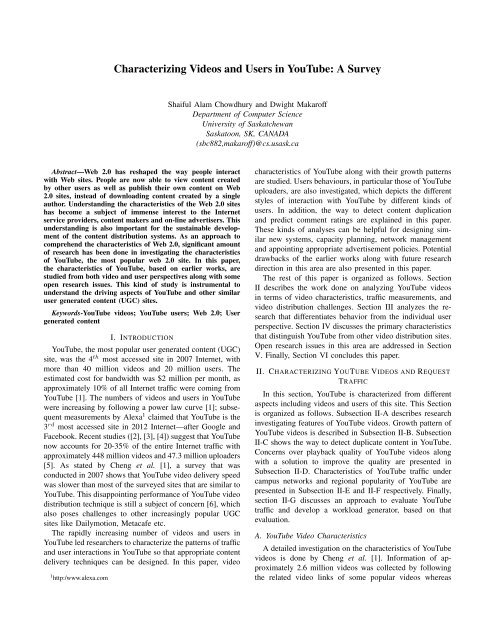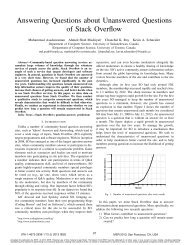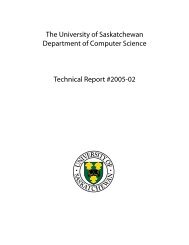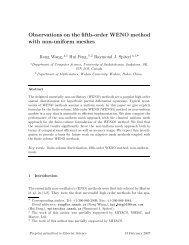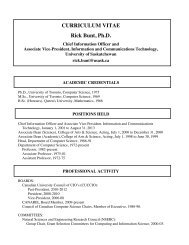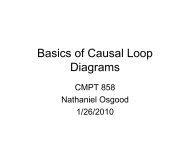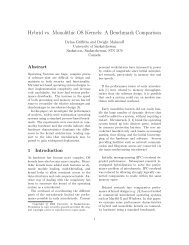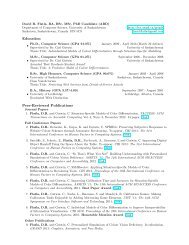Characterizing Videos and Users in YouTube: A Survey
Characterizing Videos and Users in YouTube: A Survey
Characterizing Videos and Users in YouTube: A Survey
You also want an ePaper? Increase the reach of your titles
YUMPU automatically turns print PDFs into web optimized ePapers that Google loves.
<strong>in</strong>stance, because of similar <strong>in</strong>terests, videos uploaded fromUSA exhibit similar popularity <strong>in</strong> UK, Mexico, <strong>and</strong> Canada.On the contrary, videos uploaded <strong>in</strong> Japan <strong>and</strong> Brazil enjoyon average 90% of their views <strong>in</strong> their upload<strong>in</strong>g region.The impact of social shar<strong>in</strong>g on <strong>YouTube</strong> videos popularityis <strong>in</strong>vestigated as well. Although the amount ofsocial shar<strong>in</strong>g experienced by <strong>YouTube</strong> videos is differentfor videos with different number of lifetime views, verysurpris<strong>in</strong>gly, the impact of social shar<strong>in</strong>g is found significantfor unpopular videos, while for popular videos the socialshar<strong>in</strong>g becomes less prom<strong>in</strong>ent. This paper also shows that,on average, a video tends to become popular <strong>and</strong> to peak<strong>in</strong> its own focus location (where a video has most numberof views <strong>in</strong> its lifetime), <strong>and</strong> only then this video becomespopular <strong>in</strong> other regions.The f<strong>in</strong>d<strong>in</strong>gs can be <strong>in</strong>strumental for local cach<strong>in</strong>g mechanisms<strong>and</strong> advertisement policies of <strong>YouTube</strong> <strong>and</strong> similarcontent distribution sites. However, although it is claimedthat News, Sports, <strong>and</strong> Politics videos are expected to exhibitregional popularity, unfortunately the actual names of thecategories that were found to exhibit such phenomenon werenot mentioned <strong>in</strong> this paper.G. <strong>YouTube</strong> Workload Analysis <strong>and</strong> GenerationAbhari et al. [14] design a workload generator for<strong>YouTube</strong>, <strong>and</strong> then evaluate the performance of proxycach<strong>in</strong>g with two different datasets. The first dataset (’populardataset’) is collected by us<strong>in</strong>g the st<strong>and</strong>ard feed Most-Viewed <strong>in</strong> a day <strong>and</strong> Most-viewed <strong>in</strong> a week providedby the <strong>YouTube</strong> API. On the other h<strong>and</strong> for the seconddataset (’regular dataset’), Most-Discussed, Most-Viewed,Recently-featured, <strong>and</strong> Top-Rated st<strong>and</strong>ard feeds were usedfirst. Data collection was cont<strong>in</strong>ued by follow<strong>in</strong>g the relatedl<strong>in</strong>ks of the first two datasets <strong>and</strong> thus ensur<strong>in</strong>g a significantamount of video <strong>in</strong>formation. This paper then characterizesthe properties of <strong>YouTube</strong> videos. Because of the similarcrawl<strong>in</strong>g approach, distribution of video lengths <strong>and</strong> correlationbetween length <strong>and</strong> popularity are found similar toCheng et al. [1]. Likewise, popularity of <strong>YouTube</strong> videoswas found to be fitted with heavy tail Weibull distribution.The amount of time that a video file rema<strong>in</strong>s <strong>in</strong> the mostpopular video list is also exam<strong>in</strong>ed. The short active lifespan of the popular videos is confirmed by observ<strong>in</strong>g thedaily Most viewed list provided by the <strong>YouTube</strong> API.Based on these observations, two different workload generatorswere developed: server workload generator <strong>and</strong> clientsession generator. The server workload generator simulatesthe files available on the <strong>YouTube</strong> server, whereas the clientsession generator simulates user access<strong>in</strong>g the server byselect<strong>in</strong>g a video from available videos. The client sessiongenerator was designed <strong>in</strong> a way that videos with the largervalue of view counts are more likely to be selected by theclient. Poisson distribution was used to generate subsequentrequests from a client. The performance of proxy cach<strong>in</strong>gwas measured accord<strong>in</strong>g to the request patterns generatedby the workload generator. Figure 2(a) <strong>and</strong> 2(b) depict theperformance of proxy cach<strong>in</strong>g consider<strong>in</strong>g <strong>in</strong>f<strong>in</strong>ite cache size<strong>and</strong> f<strong>in</strong>ite cache size respectively. When the cache size wasconsidered f<strong>in</strong>ite, Least Recently Used (LRU) technique wasapplied for video replacement. Figure 2(a) shows that with ahigher percentage of requests, both daily <strong>and</strong> weekly traceshave a higher hit ratio, <strong>and</strong> better hit ratio is found for longertraces (weekly) than shorter traces (daily). On the otherh<strong>and</strong>, Figure 2(a) shows that hit ratio achieved by proxycach<strong>in</strong>g <strong>and</strong> LRU policy are <strong>in</strong> the range of 12% to 90% fordifferent cache sizes.Similar to the dataset collected by Cheng et al. [1],datasets of this paper are also biased to the popular videos<strong>and</strong> suffer from similar problems. Moreover, while generat<strong>in</strong>gsubsequent requests from a client by the workloadgenerator, it was considered that a client does not send anew request without watch<strong>in</strong>g the earlier requested videocompletely, which is not a general case for <strong>YouTube</strong> videos.Likewise, the type of video object was not considered atall <strong>in</strong> this paper, which might be crucial to underst<strong>and</strong> theactual growth pattern of <strong>YouTube</strong> videos.III. CHARACTERIZING YOUTUBE USER BEHAVIOURActions other than view<strong>in</strong>g videos have an impact onthe traffic generated for the <strong>YouTube</strong> network. This sectionexplores research correlat<strong>in</strong>g this user activity <strong>in</strong>to observationsabout popularity of <strong>YouTube</strong> videos. The impactof comments <strong>and</strong> the way to predict comments rat<strong>in</strong>gs areillustrated <strong>in</strong> Subsection III-A. Subsection III-B shows thecharacteristics of <strong>YouTube</strong> uploaders whereas SubsectionIII-C analyzes behaviour of different categories of registered<strong>YouTube</strong> users.A. Predict<strong>in</strong>g Comment Rat<strong>in</strong>g <strong>in</strong> <strong>YouTube</strong>The predictability of comment rat<strong>in</strong>gs was <strong>in</strong>vestigatedby Siersdorfer et al. [15]. More than 6 million commentson 67,000 <strong>YouTube</strong> videos were collected to analyze the dependencybetween comment rat<strong>in</strong>gs <strong>and</strong> sentiment expressed<strong>in</strong> a comment. To calculate both positive <strong>and</strong> negative sensitivityof a comment, the publicly available SentiWordNetthesaurus was used. In SentiWordNet, a word is representedby three sentivalues called positive, negative, <strong>and</strong> neutral.The sentivalues are <strong>in</strong> the range of [0, 1] <strong>and</strong> sum up to1 for each triple. For example, a triple (0.875, 0.0, 0.125)represent a good word <strong>in</strong> SentiWordNet whereas (0.25,0.375, 0.375) usually represents a bad word. Sentivaluefor a comment is calculated by comput<strong>in</strong>g the averages ofpositive, negative <strong>and</strong> neutral values that are found for eachword <strong>in</strong> that comment.Observations suggest that the distribution of rat<strong>in</strong>gs isasymmetric for positive <strong>and</strong> negative rat<strong>in</strong>gs <strong>in</strong> <strong>YouTube</strong>,which suggests that the <strong>YouTube</strong> users tend to cast more positivevotes than negative. Interest<strong>in</strong>gly, 50% of the comments
(a) Inf<strong>in</strong>ite cache size(b) F<strong>in</strong>ite cache sizeFigure 2. Performance of proxy cach<strong>in</strong>g [14]are found neutrally evaluated by the users. As expected, thispaper shows that negatively rated comments tend to conta<strong>in</strong>more negative sentiment terms than positively rated comments<strong>and</strong> vice versa. Category dependencies of rat<strong>in</strong>gs arealso <strong>in</strong>vestigated <strong>in</strong> this paper, <strong>and</strong> it is found that becauseof the impartial nature of the Science videos, they presenta majority of neutral comments. Very <strong>in</strong>terest<strong>in</strong>gly, Politicsvideos are found to have significantly more negatively ratedcomments compared to other categories. On the contrary,Music videos enjoy more positively rated comments thanall other categories.Different categories of <strong>YouTube</strong> tend to attract differentk<strong>in</strong>ds of users <strong>and</strong> produce more or less discussion as afunction of the controversy of the topics. It is also depictedthat the rat<strong>in</strong>g of a comment can be predicted to someextent. The f<strong>in</strong>d<strong>in</strong>gs are useful for promot<strong>in</strong>g <strong>in</strong>terest<strong>in</strong>gcomments even <strong>in</strong> the absence of community feedback. Inother words, automatically predicted comment rat<strong>in</strong>gs canbe helpful as a supplementary rank<strong>in</strong>g criterion for searchresults. Predict<strong>in</strong>g comment rat<strong>in</strong>gs can also be useful topredict a video’s future popularity as Chatzopoulou et al.[16] found strong correlation among <strong>YouTube</strong> videos’ totalviews, number of comments, number of rat<strong>in</strong>gs <strong>and</strong> numberof favourites. However, this work would have been muchbetter if the results were verified by us<strong>in</strong>g another toolbesides SentiWordNet. 67,000 videos are not enough to drawa conclusion. Many more videos’ <strong>in</strong>formation could havebeen collected us<strong>in</strong>g the <strong>YouTube</strong> API.B. <strong>YouTube</strong> UploadersD<strong>in</strong>g et al. [5] exam<strong>in</strong>ed the uploaders’ behaviours <strong>in</strong><strong>YouTube</strong> extensively. Data analysis shows that the numberof videos uploaded by the users follows Zipf like distribution<strong>and</strong>, very surpris<strong>in</strong>gly, it shows that this upload<strong>in</strong>g ratefollows 80-20 rule, which means 80% of the videos areuploaded by only 20% of the uploaders. Not surpris<strong>in</strong>gly,numbers of subscribers for the uploaders also follow Zipflike distribution. While analyz<strong>in</strong>g the geographical locationsof the uploaders, this paper shows that approximately 31%of the videos are uploaded only by the USA users. Afteranalyz<strong>in</strong>g the social network <strong>in</strong> <strong>YouTube</strong>, results suggestthat the social users <strong>in</strong> <strong>YouTube</strong> not only upload morevideos but also their videos are watched more than thenon-social users. This paper also demonstrates that maleusers usually upload more videos than female users. F<strong>in</strong>ally,comparison between user copied content(UCC) <strong>and</strong> UGCvideos <strong>in</strong> <strong>YouTube</strong> is done. It shows that most of the popularuploaders usually uploads more UCC videos, although theirUGC videos are more popular, <strong>in</strong> terms of number of views,than their UGC videos. Some of the f<strong>in</strong>d<strong>in</strong>gs of this paperare very important. For <strong>in</strong>stance, it shows that the top 20%of the most popular uploaders attract approximately 97% ofthe total views. Moreover, it also suggests that 20% of theuploaders only upload to a s<strong>in</strong>gle category, <strong>and</strong> more than85% of the uploaders upload more than 50% of their videosonly to their three top categories. These f<strong>in</strong>d<strong>in</strong>gs can be veryuseful <strong>in</strong> order to predict the future popularity of videos attheir very early age.This paper has some mentionable drawbacks. Most ofthe results presented <strong>in</strong> this paper are based on estimation.For <strong>in</strong>stance, identification of UGC <strong>and</strong> UCC was done byexam<strong>in</strong><strong>in</strong>g sample of the videos only, <strong>and</strong> then conclusionwas drawn for the whole dataset. It would be a worthwhileresearch to identify a video’s category, UGC or UCC, bya methodological approach, which would be able to givemore accurate results. Moreover, the crawl<strong>in</strong>g approach isnot presented clearly. For example, a seed user was selectedfirst to collect its uploaded videos, <strong>and</strong> then all the relatedvideos were crawled to capture their uploaders. This processwas repeated many times with a new seed. Unfortunately,how the seed was selected is not mentioned <strong>in</strong> this paper.Likewise, BFS approach to crawl <strong>YouTube</strong> social networkcan be biased to capture only the <strong>in</strong>formation of high degreeusers. However, f<strong>in</strong>d<strong>in</strong>gs of this paper address some issuesthat need further <strong>in</strong>vestigation <strong>and</strong> thus illustrat<strong>in</strong>g some ofthe open research issues <strong>in</strong> this area.
C. User Categories <strong>in</strong> <strong>YouTube</strong>In April 2006, <strong>YouTube</strong> announced the Director program<strong>in</strong> response to a video length limitation that was imposedto prevent copyright violations. A user could apply for aDirector account after prov<strong>in</strong>g himself/herself as a legitimatecreator of his/her uploaded content, which allowed to uploadvideos longer than 10 m<strong>in</strong>utes. Then Musicians <strong>and</strong> Comediansaccounts were <strong>in</strong>troduced for publish<strong>in</strong>g performer<strong>in</strong>formation <strong>and</strong> schedule of show dates. In 2008, Guru <strong>and</strong>Reporter accounts were added. Guru is for those who likesto post videos that teach skills <strong>and</strong> how to do someth<strong>in</strong>gwhereas Reporter was for the people who likes to share news<strong>and</strong> events occurr<strong>in</strong>g around them. F<strong>in</strong>ally, Non-profit <strong>and</strong>Politician accounts were <strong>in</strong>troduced.Biel et al. [17] analyzes these user categories of <strong>YouTube</strong>along with their upload<strong>in</strong>g rate, view<strong>in</strong>g rate <strong>and</strong> socialaspects. In <strong>YouTube</strong>, a user is labeled as st<strong>and</strong>ard userwhen he/she first registers for this site. Then a user canchange his label as Director, Comedian, Musician, Guru, orReporter after apply<strong>in</strong>g for any of these profiles. Statisticssuggest that most of the users (almost 90%) <strong>in</strong> <strong>YouTube</strong> donot belong to any of these special categories <strong>and</strong> cont<strong>in</strong>uetheir watch<strong>in</strong>g or shar<strong>in</strong>g as st<strong>and</strong>ard users. Results suggestthat <strong>in</strong> spite of their lower numbers <strong>in</strong> <strong>YouTube</strong>, the specialusers contribute more than the st<strong>and</strong>ard users, consider<strong>in</strong>gupload<strong>in</strong>g, watch<strong>in</strong>g <strong>and</strong> subscrib<strong>in</strong>g. This <strong>in</strong>dicates thatonly the active users are <strong>in</strong>terested about these categories,<strong>and</strong> many of the users are still not aware of these categoriesbecause of the poor advertisement of <strong>YouTube</strong>. Similar toprevious studies, this paper also shows that, <strong>in</strong> <strong>YouTube</strong>,male users dom<strong>in</strong>ate female users <strong>in</strong> terms of upload<strong>in</strong>gvideos, watch<strong>in</strong>g videos. On the contrary, it is found thatfemale users are more social <strong>in</strong> <strong>YouTube</strong> than male usersas they have more subscribers, subscriptions, <strong>and</strong> they alsofavourite more videos than male users. Interest<strong>in</strong>gly, thispaper shows that although Politicians <strong>and</strong> Reporters uploadsmany videos, their number of watched videos is very low,which <strong>in</strong>dicates that these people are more <strong>in</strong>terested <strong>in</strong>releas<strong>in</strong>g their work or spread<strong>in</strong>g their messages, rather thanexplor<strong>in</strong>g people’s <strong>in</strong>terests. This paper is a good exampleto show how <strong>YouTube</strong> can be used to reveal the attitudes<strong>and</strong> behaviours of different k<strong>in</strong>ds of people.IV. COMPARISON BETWEEN YOUTUBE AND OTHERNON-UGC SITESCha et al. [9] shows that characteristics of <strong>YouTube</strong> aresignificantly different than non-UGC sites. In case of contentupload<strong>in</strong>g rates, as of June 9 th , 2008, the largest on-l<strong>in</strong>emovie data-base IMDb carried only 1,039,447 movies <strong>and</strong>TV episodes, whereas approximately 65,000 videos werebe<strong>in</strong>g uploaded daily <strong>in</strong> <strong>YouTube</strong>. This statistics implies thatto produce the same number of videos as listed <strong>in</strong> IMDb, ittakes only 15 days for <strong>YouTube</strong>. While compar<strong>in</strong>g the videopublishers between <strong>YouTube</strong> <strong>and</strong> non-UGC sites, based onLovefilm, this paper shows that <strong>in</strong> <strong>YouTube</strong> there are somepublishers who post more than 1000 new videos over a fewyears whereas it usually takes more than 50 years for a s<strong>in</strong>gleproducer to produce 100 movies <strong>in</strong> the film <strong>in</strong>dustry.Not surpris<strong>in</strong>gly, <strong>YouTube</strong> videos are found shorter thannon-UGC by two orders of magnitude, although the lengthof <strong>YouTube</strong> videos varies accord<strong>in</strong>g to the category. In orderto compare the view<strong>in</strong>g rates, <strong>in</strong>formation was collectedfrom Netflix <strong>and</strong> Yahoo! Movies whereas views of Science& Technology videos were collected from <strong>YouTube</strong>. ForNetflix movies, customer rat<strong>in</strong>gs were used to estimate thenumber of views s<strong>in</strong>ce <strong>in</strong>formation about views are notprovided by Netflix. Results suggest that lot of <strong>YouTube</strong>videos have no views, while all the movies <strong>in</strong> Netflix <strong>and</strong>Yahoo! Movies have been watched at least once. However,the scale of consumers per video is very different for<strong>YouTube</strong> <strong>and</strong> non-UGC. The views distribution of <strong>YouTube</strong>spans more than 6 orders of magnitude, while the number ofrat<strong>in</strong>gs per movie <strong>in</strong> Netflix <strong>and</strong> Yahoo! Movies span about 4orders of magnitude. This observation illustrates the naturaldiversity of <strong>in</strong> <strong>YouTube</strong> uploader <strong>and</strong> consumer population.Unlike the non-UGC sites, it is found that most of thepopular Science & Technology videos <strong>in</strong> <strong>YouTube</strong> have<strong>in</strong>com<strong>in</strong>g l<strong>in</strong>ks from external sites. Surpris<strong>in</strong>gly, <strong>in</strong> spiteof that enormous number of <strong>in</strong>com<strong>in</strong>g l<strong>in</strong>ks, the authorsobserved that only 3% of the total views comes from theseexternal sites. This paper also suggests that video popularity<strong>in</strong> <strong>YouTube</strong> follows a power-law distribution with an exponentialcutoff. Although f<strong>in</strong>d<strong>in</strong>gs of this paper illustratethe differences between <strong>YouTube</strong> <strong>and</strong> non-UGC sites veryclearly, it is not clear why the authors considered Science<strong>and</strong> Technology videos while compar<strong>in</strong>g with Netflix <strong>and</strong>Yahoo! Movies. <strong>YouTube</strong> itself has a category named Film& Animation, which should be the perfect selection for thispart of the analysis.V. OPEN RESEARCH ISSUESScalability is considered as one of the most importantissues <strong>in</strong> <strong>YouTube</strong> like sites because of the freedom <strong>in</strong>video upload<strong>in</strong>g. Peer-to-peer techniques, <strong>in</strong> spite of theirpromis<strong>in</strong>g solution to the scalability problem, can not bedeployed without appropriate modifications, especially withtheir <strong>in</strong>centive mechanisms. Impos<strong>in</strong>g restrictions <strong>in</strong> downloadspeed for example, which is employed by the <strong>in</strong>centivemechanisms, can contribute oppositely to the currentpopularity of <strong>YouTube</strong> <strong>and</strong> other UGC sites. This area ofvideo distribution needs further extensive research. Alongwith P2P techniques, other well known video distributionapproaches like batch<strong>in</strong>g <strong>and</strong> patch<strong>in</strong>g can be <strong>in</strong>vestigated.For example, it would be worthwhile to <strong>in</strong>vestigate theperformance of batch<strong>in</strong>g for <strong>YouTube</strong> live stream<strong>in</strong>g; batch<strong>in</strong>ghas been proved as potential c<strong>and</strong>idate to improve theplayback quality for this k<strong>in</strong>ds of video distributions. Forcach<strong>in</strong>g mechanism, multilayer cach<strong>in</strong>g policies can improve
the buffer<strong>in</strong>g delay. Given the regional popularity of videos[13], different local cach<strong>in</strong>g approaches can be developed.In case of local cache miss, the request will be forwardedto the central server such that videos <strong>in</strong> central server arecached <strong>in</strong> a way that reflects the global popularity of videos.Content alias<strong>in</strong>g <strong>in</strong> <strong>YouTube</strong> is another issue of concernfor the on-l<strong>in</strong>e marketers, which is responsible to distortthe popularity of the orig<strong>in</strong>al videos. Although the way todetect duplicate content is suggested by Pedro et al. [8], nowork has been done that <strong>in</strong>vestigate the way to elim<strong>in</strong>ateduplicate content from <strong>YouTube</strong> at their very early ages,which can help to m<strong>in</strong>imize the impact of duplicate videoson the orig<strong>in</strong>al video’s popularity. Consider<strong>in</strong>g the types ofvideo objects while analyz<strong>in</strong>g the time-vary<strong>in</strong>g popularitycan contribute to properly underst<strong>and</strong> the growth patternof videos. It is likely that some of the categories, News<strong>and</strong> Sports for examples, experience most of the views attheir very early ages. This k<strong>in</strong>d of analysis might not onlyimprove the cach<strong>in</strong>g mechanism but also can be beneficialfor appo<strong>in</strong>t<strong>in</strong>g appropriate advertisement policies.VI. CONCLUSIONIn this paper, we <strong>in</strong>vestigated several aspects of <strong>YouTube</strong><strong>in</strong>clud<strong>in</strong>g video characteristics, content redundancy, playbackquality, <strong>and</strong> users behaviours. Although some of theresults are found very similar among different studies, allof them are presented <strong>in</strong> this paper <strong>in</strong> order to identifythe results that do not need further verification. On thecontrary, some of the results are found contradictory amongdifferent studies that need further exam<strong>in</strong>ation. For example,Cheng et al. [1] suggest that P2P technique with appropriatemodification is the best c<strong>and</strong>idate to solve the scalabilityissue of <strong>YouTube</strong>, where exactly opposite result is found byZ<strong>in</strong>k et al. [11]. This study can be helpful for future researchon <strong>YouTube</strong>, as potential drawbacks of the earlier works arealso analyzed.REFERENCES[1] X. Cheng, C. Dale, <strong>and</strong> J. Liu, “Underst<strong>and</strong><strong>in</strong>g the Characteristicsof Internet Short Video Shar<strong>in</strong>g: <strong>YouTube</strong> as a CaseStudy,” Cornell University, arXiv e-pr<strong>in</strong>ts, Tech. Rep., July2007.[2] A. Gember, A. An<strong>and</strong>, <strong>and</strong> A. Akella, “A Comparative Studyof H<strong>and</strong>held <strong>and</strong> Non-h<strong>and</strong>held Traffic <strong>in</strong> Campus Wi-FiNetworks,” <strong>in</strong> PAM 2011, Atlanta, GA, March 2011, pp. 173–183.[3] C. Labovitz, S. Iekel-Johnson, D. McPherson, J. Oberheide,<strong>and</strong> F. Jahanian, “Internet Inter-Doma<strong>in</strong> Traffic,” <strong>in</strong> ACMSIGCOMM 2010, New Delhi, India, August 2010.[5] Y. D<strong>in</strong>g, Y. Du, Y. Hu, Z. Liu, L. Wang, K. Ross, <strong>and</strong> G. A,“Broadcast Yourself: Underst<strong>and</strong><strong>in</strong>g <strong>YouTube</strong> Uploaders,” <strong>in</strong>IMC 2011, Berl<strong>in</strong>, Germany, November 2011, pp. 361–370.[6] S. Khemmarat, R. Zhou, L. Gao, <strong>and</strong> M. Z<strong>in</strong>k, “Watch<strong>in</strong>gUser Generated <strong>Videos</strong> with Prefetch<strong>in</strong>g,” <strong>in</strong> MMSYS 2011,San Jose, CA, February 2011, pp. 187–198.[7] Y. Borghol, S. Mitra, S. Ardon, N. Carlsson, D. Eager, <strong>and</strong>A. Mahanti, “<strong>Characteriz<strong>in</strong>g</strong> <strong>and</strong> Modell<strong>in</strong>g Popularity ofUser-Generated <strong>Videos</strong>,” Performance Evaluation, vol. 68,pp. 1037–1055, November 2011.[8] J. Pedro, S. Siersdorfer, <strong>and</strong> M. S<strong>and</strong>erson, “Content Redundancy<strong>in</strong> <strong>YouTube</strong> <strong>and</strong> its Application to Video Tagg<strong>in</strong>g,”ACM Transactions on Information Systems, vol. 29, no. 3,pp. 13:1–13:31, July 2011.[9] M. Cha, H. Kwok, P. Rodriguez, Y. Ahn, <strong>and</strong> S. Moon, “Analyz<strong>in</strong>gthe Video Popularity Characteristics of Large-ScaleUser Generated Content Systems,” IEEE/ACM Transactionson Network<strong>in</strong>g, vol. 17, no. 5, pp. 1357 –1370, October 2009.[10] H. Shachnai <strong>and</strong> P. S. Yu, “Explor<strong>in</strong>g wait tolerance <strong>in</strong> effectivebatch<strong>in</strong>g for video-on-dem<strong>and</strong> schedul<strong>in</strong>g,” MultimediaSystems, vol. 6, no. 6, pp. 382–394, November 1998.[11] M. Z<strong>in</strong>k, K. Suh, Y. Gu, <strong>and</strong> J. Kurose, “Characteristicsof <strong>YouTube</strong> Network Traffic at a Campus Network - Measurements,Models, <strong>and</strong> Implications,” Computer Networks,vol. 53, no. 4, pp. 501–514, March 2009.[12] P. Gill, M. Arlitt, Z. Li, <strong>and</strong> A. Mahanti, “<strong>YouTube</strong> TrafficCharacterization: A View From the Edge,” <strong>in</strong> IMC 2007, SanDiego, California, October 2007, pp. 15–28.[13] A. Brodersen, S. Scellato, <strong>and</strong> M. Wattenhofer, “YoutubeAround the World: Geographic Popularity of <strong>Videos</strong>,” <strong>in</strong>WWW 2012, Lyon, France, April 2012.[14] A. Abhari <strong>and</strong> M. Soraya, “Workload Generation for<strong>YouTube</strong>,” Multimedia Tools <strong>and</strong> Applications, vol. 46, no. 1,pp. 91–118, January 2010.[15] S. Siersdorfer, S. Chelaru, W. Nejdl, <strong>and</strong> J. S. Pedro,“How Useful are Your Comments?: Analyz<strong>in</strong>g <strong>and</strong> Predict<strong>in</strong>gYoutube Comments <strong>and</strong> Comment Rat<strong>in</strong>gs,” <strong>in</strong> WWW 2010,Raleigh, NC, April 2010, pp. 891–900.[16] G. Chatzopoulou, C. Sheng, <strong>and</strong> M. Faloutsos, “A First StepTowards Underst<strong>and</strong><strong>in</strong>g Popularity <strong>in</strong> <strong>YouTube</strong>,” <strong>in</strong> 2010INFOCOM Workshops, San Diego, CA, March 2010, pp. 1–6.[17] J. Biel <strong>and</strong> D. Gatica-Perez, “Wear<strong>in</strong>g a <strong>YouTube</strong> Hat: Directors,Comedians, Gurus, <strong>and</strong> User Aggregated Behavior,”<strong>in</strong> ACM Multimedia 2009, Beij<strong>in</strong>g, Ch<strong>in</strong>a, October 2009, pp.833–836.[4] G. Maier, F. Schneider, <strong>and</strong> A. Feldmann, “A First Lookat Mobile H<strong>and</strong>-held Device Traffic,” <strong>in</strong> PAM 2010, Zurich,Switzerl<strong>and</strong>, April 2010, pp. 161–170.


